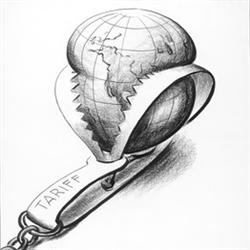The Economic Implications of Tariffs: A Look Ahead

In a bold move to reshape trade dynamics, President Trump recently rolled out a foundational tariff structure, positioning a 10% tariff on imports from various nations, with even steeper penalties—sometimes reaching 50%—aimed at countries such as China, Japan, and many in Europe. While some applaud protectionist measures as steps towards reviving American manufacturing, these tariffs are controversial and could lead to significant global economic ramifications. Here at Extreme Investor Network, we aim to shed light on the deeper implications of these policies and the economic landscape they may create.
The Lessons of History: Will We Repeat Past Mistakes?
The introduction of tariffs in 2024 echoes the Smoot-Hawley Tariff Act of 1930, which raised tariffs on thousands of goods in an attempt to protect American jobs during the Great Depression. Economists universally criticize this act for plunging global trade into a deeper crisis, demonstrating that high tariffs can backfire spectacularly. The reality is that many of the crises we face today can be traced back to similar policy missteps, where tariffs were used as a blunt instrument rather than a carefully calibrated economic tool.
As we stand on the precipice of what some are predicting could turn into a recession—possibly lasting until August 25, 2028—it’s crucial to learn from the past. Economic downturns often reveal a larger underlying issue, such as massive public and private debt, which is currently a global phenomenon. The real question is: who will bear the blame? It’s likely that, just as before, political leaders will emerge as scapegoats even when broader economic forces are at play.
A Complex Web: Tariffs, Trade, and Politics
The new tariffs will not only impact the U.S. economy but will also initiate a ripple effect throughout the global market. Countries like the UK, benefiting from lower tariffs compared to the EU, may experience shifts in supply chains, prompting manufacturers to redirect goods through the UK to evade tariffs. While this could create short-term advantages for the UK, systemic issues remain unresolved.
In the grand scheme of things, such protective measures often come at the expense of consumers—leading to higher prices for everyday goods and reduced living standards. For instance, domestic products might cost 20% more due to tariffs, distorting the market rather than fostering the intended economic growth.
The Political Landscape of Economic Decisions
The political climate surrounding tariffs is undeniably complex. Despite economic forecasts predicting a downturn, blame will be apportioned disproportionately to President Trump and his administration, with economists—many of whom carry nuanced biases—swiftly denouncing protectionist policies. Here at Extreme Investor Network, we believe it is critical to maintain objectivity. While some of these tariffs may be warranted, especially given unfair practices from trading partners, overall, they stem from deeper issues of global economic imbalance.
Our own research and data models warn of further macroeconomic disruptions. Leading indicators suggest that increasing tensions fueled by trade wars can have far-reaching implications, extending beyond mere economics into geopolitical territory. Our proprietary analytical tools highlight that the next decade may not just see economic strife but also social transformations driven by these tariffs.
Historical Context: The Great Depression and Economic Recovery
As we navigate these precarious waters, it’s vital to understand how previous economic crises were handled. The widely heralded New Deal was not merely an economic policy but a political response to the failures of the Smoot-Hawley tariffs and other protectionist measures. We must not forget that in 1931, countries like Canada abandoned the gold standard to counteract economic pressures—a move toward flexibility that ultimately offered a way out of stagnation.
The Economic Cycle Continues
The current trajectory suggests that we may be repeating historical patterns. The reality is that recessions often emerge from a lack of understanding of capital flows and currency dynamics—factors that far surpass the influence of tariffs alone.

In examining John Kenneth Galbraith’s classic "The Great Crash," we discern that the real issues were not merely economic policies but rather systemic failures by politicians and policymakers. The historical narrative is often clouded by political rhetoric, which can obscure the roots of economic problems that require government accountability rather than capitalist scapegoating.
The Future of Economic Policy
As we look forward, it is essential to approach these turbulent times with a clear perspective. While tariffs might seem like a viable strategy for fostering local growth, it’s imperative to consider their broader economic implications. At Extreme Investor Network, we stress the importance of making informed decisions based on comprehensive data rather than ideological biases.
The global economy is on the brink of significant shifts, and understanding the past can offer critical insights into what lies ahead. Keep following our blog for more updates as we delve deeper into these pressing issues, providing insights designed to help you navigate the complexities of today’s economic landscape. Together, we can turn challenges into opportunities.

